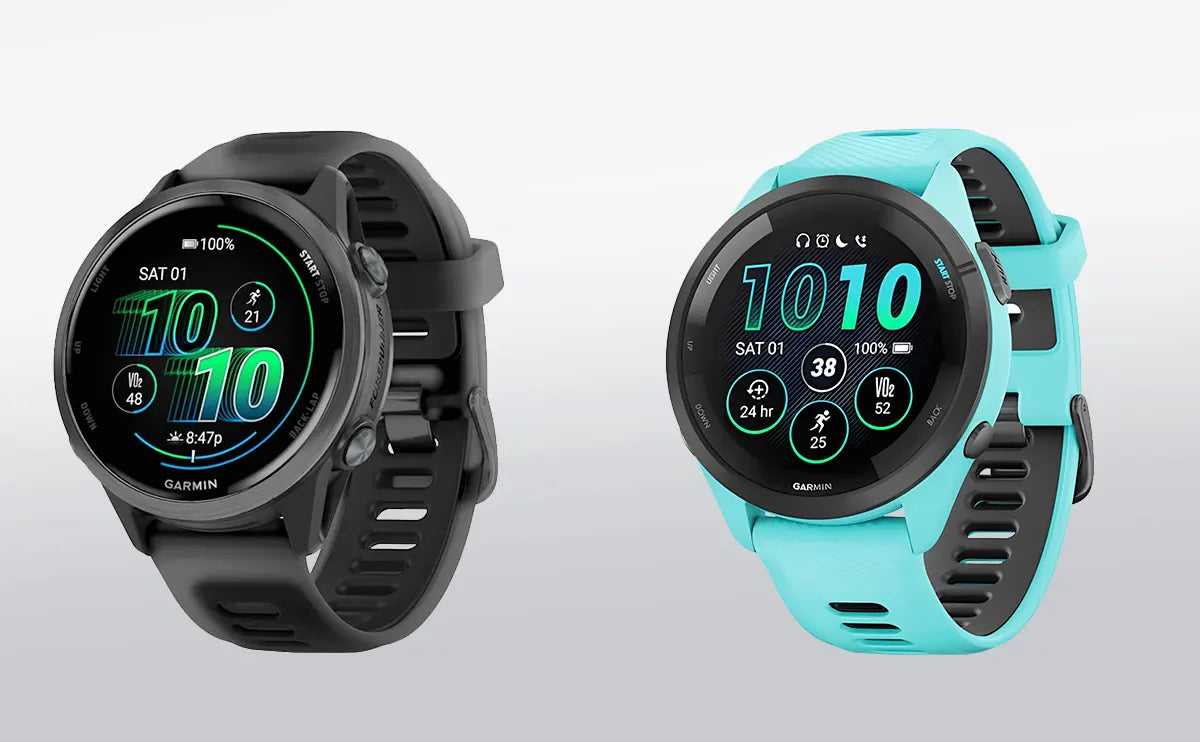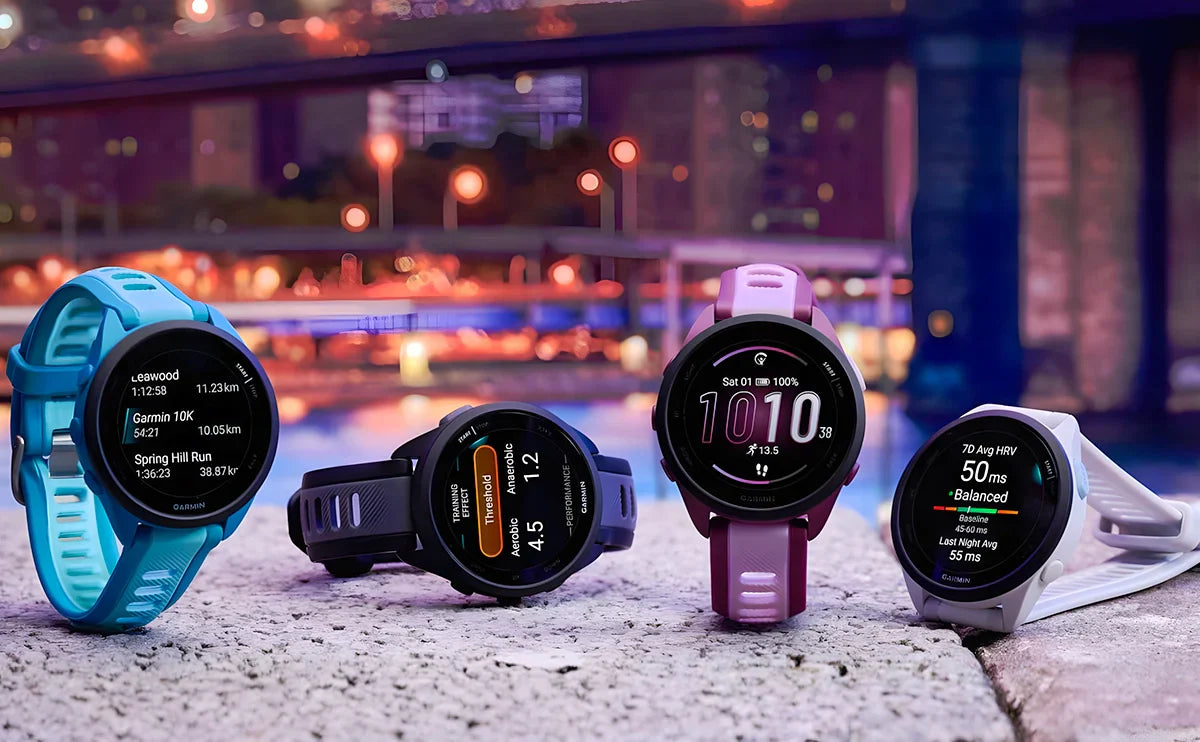Main content:
- Design, Size & Weight - Refined Finish vs Lightweight Classic
- Screen Quality & Brightness - Larger, Brighter vs Compact and Clear
- Battery Life - Balanced Endurance vs Extended Basic Use
- Sensors & Tracking - Advanced Precision vs Reliable Essentials
- Health & Sports Features - Advanced Insights vs Essential Tracking
- Price - Premium Features vs Smart Savings
- Smart Features - Voice-Enabled Convenience vs Practical Essentials
- Garmin Forerunner 570 vs Forerunner 265 - Conclusion and User Recommendations
In the world of sports watches, Garmin has long been a trusted name among professional runners and fitness enthusiasts. With the launch of the Garmin Forerunner 570, many users are now comparing it to the highly regarded Forerunner 265. Both models feature AMOLED touchscreens, comprehensive training tools, and advanced health monitoring, but they differ significantly in key aspects that affect daily use.
Released in 2025, the Forerunner 570 introduces several upgrades, including an enhanced display, built-in microphone and speaker for voice calls and smart assistant support, and up to 18 hours of GPS battery life - making it ideal for long training sessions. On the other hand, the Forerunner 265, launched in 2023, continues to be a popular choice with its mature and reliable performance, offering up to 13 days of battery life in smartwatch mode and advanced running features.
So, if you're looking to buy your first running watch - or deciding whether to upgrade from the 265 to the 570 - this article will guide you through a comprehensive comparison across five key areas: design, features, battery life, GPS capabilities, and price. Let’s dive in and help you find the model that truly fits your needs.
Also Read Other Garmin Forerunner Watch Review and Comparison Articles Below:
Garmin Forerunner 970 vs Fenix 8
Design, Size & Weight - Refined Finish vs Lightweight Classic
In terms of design, the Garmin Forerunner 570 clearly feels more premium. It features an aluminum bezel and round metal buttons, offering a modern and refined look. The color options are also more vibrant, with choices like mango yellow, purple, and even semi-transparent bands that stand out visually.
By comparison, the Forerunner 265 uses a polymer bezel, which keeps the watch lightweight and practical but lacks the same premium feel. Its capsule-shaped buttons are functional but more traditional in appearance.
As for size and weight:
- 570 comes in two versions: 42mm (42g) and 47mm (50g)
- 265 is available in 42mm and 46mm, with a typical weight of around 47g
Both watches are comfortable to wear, but the 570 offers a more polished and modern design, appealing to users who value both aesthetics and performance.
Winner: Garmin Forerunner 570
Reason: It uses higher-end materials and delivers a more modern, thoughtful design.

Screen Quality & Brightness - Larger, Brighter vs Compact and Clear
Both Garmin Forerunner 570 and 265 use AMOLED touchscreens, but the 570 clearly leads with a bigger and brighter display. The larger 47mm 570 sports a 1.4-inch screen with a sharp 454×454 resolution, surpassing the 265’s 1.3-inch 416×416 display in clarity and detail.
Brightness is a standout difference: the 570 offers roughly twice the maximum brightness of the 265, making it far easier to read under strong sunlight. Even at minimum brightness, the 570 screen appears noticeably brighter and more vibrant.
The 570’s smaller 42mm model has a 1.2-inch screen (390×390), slightly smaller than the 265’s 1.3-inch, but overall the 570’s larger version dominates in display quality. Both watches have slightly raised screens, so care is needed to avoid scratches.
Winner: Garmin Forerunner 570
Reason: Offers a larger, significantly brighter screen with higher resolution for better outdoor visibility and richer visuals.
Battery Life - Balanced Endurance vs Extended Basic Use
The Garmin Forerunner 570 and 265 each excel in different battery usage scenarios.
The 570 offers up to 11 days in smartwatch mode and 18 hours in GPS mode. When playing music, battery life reduces to 9 hours, but even with SatIQ or multi-GNSS systems enabled alongside music playback, it still lasts around 8 hours, delivering a well-rounded endurance for heavy usage. It also features customizable low battery alerts to help manage charging.
On the other hand, the 265 shines in lighter daily use, providing up to 13 days in smartwatch mode and 20 hours in GPS mode. However, its battery drains faster under music playback and advanced GPS settings, lasting about 7 hours with GPS and music, and less than 6.5 hours with multi-frequency GPS.
Overall, the 265 offers longer basic battery life, ideal for users prioritizing extended daily use, while the 570 performs better under heavy, multi-feature usage with more stable battery endurance.
Winner: Garmin Forerunner 570
Reason: Superior battery life under heavy usage, perfect for power users who utilize advanced features.

Sensors & Tracking - Advanced Precision vs Reliable Essentials
Both Garmin Forerunner 570 and 265 come equipped with a comprehensive set of built-in sensors, including optical heart rate monitors, accelerometers, barometers, electronic compasses, temperature sensors, and multi-frequency GNSS positioning systems. However, the 570 features more advanced sensor technology and broader functionality.
The 570 uses the upgraded fifth-generation Garmin Elevate optical heart rate sensor, which includes a brighter LED array with green and red lights to improve heart rate and blood oxygen accuracy across different skin tones and intense workouts. It also supports skin temperature monitoring, aiding in sleep and health analysis. The 265 features the fourth-generation sensor, which offers reliable accuracy but falls slightly behind the 570. It also supports wrist-based running dynamics and training readiness features.
Regarding GPS, the 570 supports multi-frequency multi-constellation positioning with smart satellite selection (SatIQ), delivering faster satellite acquisition and more stable tracking in complex environments. The 265 also supports multi-frequency GNSS (GPS, GLONASS, Galileo) with gyroscope compensation, maintaining a positioning error within ±3 meters and offering consistent performance.
In terms of external sensor compatibility, the 570 supports a wider range of professional accessories such as running power meters, running dynamics sensors, and bike cadence and speed sensors. The 265 supports basic sensors like heart rate straps and foot pods.
Additionally, the 570 includes a built-in speaker and microphone to support calling functionality, enhancing the smart experience.
Overall, the 570 offers a more comprehensive sensor package suited for users demanding precise training data, while the 265 meets the needs of everyday runners and basic training.
Winner: Garmin Forerunner 570
Reason: More advanced sensors and wider external accessory support enable more precise training.
Health & Sports Features - Advanced Insights vs Essential Tracking
The Garmin Forerunner 570 and 265 differ significantly in health and sports capabilities.
Health Monitoring:
The 570 features the fifth-generation heart rate sensor, delivering accurate readings across various skin tones and activity intensities. It includes a skin temperature sensor and offers a “Good Night” report that combines training, recovery, and weather data to provide personalized sleep guidance. The 265 uses a fourth-generation heart rate sensor with slightly less accuracy and lacks skin temperature monitoring and the advanced sleep report, offering more basic health tracking.
Sports Features:
Both support core activities like running, cycling, swimming, and triathlon modes. The 570 adds obstacle racing, ultramarathon, gravel cycling, and multi-sport workouts, catering to more diverse training needs. It includes a speaker for real-time audio announcements of heart rate, pace, and distance, while the 265 requires users to check the screen for data.
Additionally, the 570 supports track detection for precise lap tracking and offers Garmin’s Triathlon Coach feature with professional training plans and race predictions. The 265 focuses on essential running and fitness functions without these advanced tools.
Golf enthusiasts will appreciate the 570’s Garmin Golf app with course maps and distance measurement, which the 265 lacks.
Overall, the 570 delivers a broader, smarter suite of health and sports features suited for users seeking diverse workouts and in-depth data, whereas the 265 serves well as a straightforward device for everyday fitness tracking.
Winner: Garmin Forerunner 570
Reason: More comprehensive features supporting diverse sports and advanced health insights for serious athletes.
Price - Premium Features vs Smart Savings
The Garmin Forerunner 570 is priced at $550, reflecting its high-end position with added features like a built-in microphone, speaker, advanced sensors, and expanded sport modes. In contrast, the Forerunner 265 has seen significant price drops since its release and is now widely available for around $350, making the price gap nearly $200.
While the 570 offers more advanced features, the 265 delivers all the essential tools most users need at a far more affordable price, making it a strong value pick for everyday runners and fitness enthusiasts.
Winner: Garmin Forerunner 265
Reason: Offers essential features at a significantly lower price, making it a better value for most users.
Smart Features - Voice-Enabled Convenience vs Practical Essentials
The Forerunner 570 takes a big leap in smart functionality with its built-in microphone and speaker. It allows you to take Bluetooth calls, use voice assistants like Siri or Google Assistant, and execute offline voice commands such as “start a run” or “set a timer.” These features make daily use smoother and push the 570 closer to a true smartwatch experience.
In contrast, the Forerunner 265 lacks both a mic and speaker. It still supports smart notifications, offline music playback via connected earbuds (Spotify, Amazon Music, etc.), Garmin Pay, incident detection, and LiveTrack, making it highly capable for fitness-focused users - but more limited in interactive smart features.
If you want a watch that can keep up with your workouts and your daily tasks with hands-free convenience, the 570 stands out.
Winner: Garmin Forerunner 570
Reason: Its built-in voice calling and offline voice controls deliver a more complete and modern smart experience.

Garmin Forerunner 570 vs Forerunner 265 - Conclusion and User Recommendations
After a detailed comparison of the Garmin Forerunner 265 and 570, it’s clear that both watches have distinct strengths tailored for different types of users. The Forerunner 265 stands out with its excellent battery life, lightweight design, and smart training plans, making it an ideal choice for daily runners and health monitoring enthusiasts. It offers great value, especially for those on a budget.
On the other hand, the Forerunner 570 targets serious runners and multi-sport athletes who need voice call support, offline voice commands, and more precise physiological tracking. It’s perfect for users who demand advanced smart interactions and high-intensity training features.
Additionally, I’ve also created reviews and a comparison video covering Garmin Forerunner 970 vs. Garmin Forerunner 570, as well as insights into Garmin 970 vs 965 and the differences between Garmin Forerunner 955 vs Garmin Forerunner 965 to help you choose the right model. If you’re interested, feel free to check them out to make a more informed decision.
|
User Type |
Recommended Model |
Reason |
|
Daily Running & Health Focus |
Forerunner 265 |
Long battery life, smart training, lightweight and portable |
|
Full Marathon, Pro Training, Voice Interaction |
Forerunner 570 |
Voice call support, in-depth physiological data, professional GPS |
|
Budget-Conscious |
Forerunner 265 |
Higher cost-performance ratio |
|
Budget Flexible & Feature-Rich |
Forerunner 570 |
More comprehensive features and smart interactions |
In summary, choosing the right sports watch depends on balancing your functional needs with your budget to find the best companion that enhances both your training and daily life.





Share:
Upcoming Apple Watch SE 3 - Leaks, Features, and Release Date Predictions
Samsung Galaxy Watch 4 vs. Galaxy Watch 4 Classic - Which One Should You Really Buy in 2025?